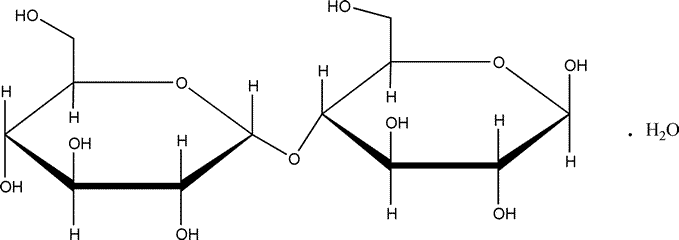Maltose
»Maltose is a sugar.It contains one molecule of water of hydration or is anhydrous.It contains not less than 92.0percent of maltose,calculated on the anhydrous basis.The amounts of other sugars,if detected,are not included in the requirements or the calculated amount underOther Impurities.
Packaging and storage—
Preserve in well-closed containers.Store at room temperature.
Identification—
A:
Add 2to 3drops of a solution of Maltose (1in 20)to 5mLof hot alkaline cupric tartrate TS.Ared precipitate is formed.
B:
The retention time of the major peak in the chromatogram of theAssay preparationcorresponds to that of the chromatogram of theStandard preparation,as obtained in theAssay.
pHá791ñ—
Prepare a 1in 10solution in carbon dioxide-free water.For the anhydrous form,it is between 3.7and 4.7and for the monohydrate form,it is between 4.0and 5.5.
Water,Method Iá921ñ—
The anhydrous form contains not more than 1.5%.The monohydrate form contains not less than 5.0%and not more than 6.5%.
Residue on ignition á281ñ:
not more than 0.05%,determined on a 2-g portion,accurately weighed.
Heavy metals,Method Iá231ñ:
not more than 5µg per g.
Dextrin,starch,and sulfite—
Dissolve 1.0g of Maltose in 10mLof water,and add 1drop of iodine TS:a yellow color develops.Then add 1drop of starch TSto this portion:a blue color develops.
Assay—
Mobile phase—
Use degassed water.
Resolution solution—
Dissolve accurately weighed quantities of maltotriose,maltose,and glucose in water,to obtain a solution having concentrations of about 10mg of each per g.
Standard preparation—
Dissolve an accurately weighed quantity of USP Maltose Monohydrate RSin water,to obtain a solution having a concentration of about 10mg per g.Calculate the exact concentration on the anhydrous basis.
Assay preparation—
Dissolve about 0.10g of Maltose,accurately weighed,in water,and dilute with water to about 10g.Accurately record the final solution weight,and mix thoroughly.
Chromatographic system(see Chromatography á621ñ)—
The liquid chromatographic system is equipped with a refractive index detector maintained at a constant temperature of about 40 ,and a 7.8-mm ×30-cm column that contains packing L58(see Chromatography á621ñ).The column temperature is maintained at about 80
,and a 7.8-mm ×30-cm column that contains packing L58(see Chromatography á621ñ).The column temperature is maintained at about 80 ,controlled to within ±2
,controlled to within ±2 .Chromatograph theResolution solution,and record the peak responses as directed forProcedure.Adjust the flow rate to about 0.35mLper minute so that the resolution,R,between maltotriose and maltose is not less than 1.6.Chromatograph theStandard preparation,and record the peak responses as directed forProcedure:the relative retention times are about 0.9for maltotriose,1.0for maltose,and 1.2for glucose;and the relative standard deviation for replicate injections is not more than 2.0%.
.Chromatograph theResolution solution,and record the peak responses as directed forProcedure.Adjust the flow rate to about 0.35mLper minute so that the resolution,R,between maltotriose and maltose is not less than 1.6.Chromatograph theStandard preparation,and record the peak responses as directed forProcedure:the relative retention times are about 0.9for maltotriose,1.0for maltose,and 1.2for glucose;and the relative standard deviation for replicate injections is not more than 2.0%.
Procedure—
Separately inject equal volumes (about 20µL)of theStandard preparationand theAssay preparationinto the chromatograph,record the chromatograms,and measure the responses for the major peaks.Calculate the percentage of Maltose on the anhydrous basis,taken by the formula:
[10,000(CS/CU)(rU/rS)]/(100–W),
in which CSis the concentration,in mg per g,on the anhydrous basis of USP Maltose Monohydrate RSin theStandard preparation;CUis the concentration,in mg per g,of Maltose in theAssay preparation;rUand rSare the peak responses obtained from theAssay preparationand theStandard preparation,respectively;and Wis the percentage obtained in the test forWater.
Auxiliary Information—
Staff Liaison:Catherine Sheehan,B.Sc.,Scientist
Expert Committee:(EMC)Excipients:Monograph Content
USP28–NF23Page 3034
Pharmacopeial Forum:Volume No.30(3)Page 985
Phone Number:1-301-816-8262
